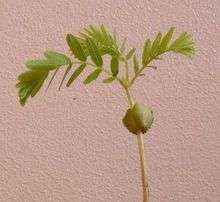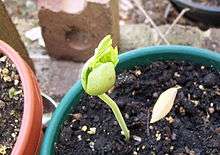Tamarind
| Tamarind | |
|---|---|
| | |
| Scientific classification | |
| Kingdom: | Plantae |
| (unranked): | Angiosperms |
| (unranked): | Eudicots |
| (unranked): | Rosids |
| Order: | Fabales |
| Family: | Fabaceae |
| Subfamily: | Caesalpinioideae |
| Tribe: | Detarieae |
| Genus: | Tamarindus L. |
| Species: | T. indica |
| Binomial name | |
| Tamarindus indica L. | |
| Synonyms | |
| |
Tamarind (Tamarindus indica) is a leguminous tree in the family Fabaceae indigenous to tropical Africa. The genus Tamarindus is a monotypic taxon, having only a single species.
The tamarind tree produces edible, pod-like fruit which is used extensively in cuisines around the world. Other uses include traditional medicine and metal polish. The wood can be used in carpentry. Because of the tamarind's many uses, cultivation has spread around the world in tropical and subtropical zones.
Origin
Tamarindus indica is probably indigenous to tropical Africa,[2] but has been cultivated for so long on the Indian subcontinent that it is sometimes also reported to be indigenous there.[3] It grows wild in Africa in locales as diverse as Sudan, Cameroon, Nigeria and Tanzania. In Arabia, it is found growing wild in Oman, especially Dhofar, where it grows on the sea-facing slopes of mountains. It reached South Asia likely through human transportation and cultivation several thousand years prior to the Common Era.[4][5] It is widely distributed throughout the tropical belt, from Africa to South Asia, Northern Australia, and throughout Oceania, Southeast Asia, Taiwan and China.
In the 16th century, it was heavily introduced to Mexico, and to a lesser degree to South America, by Spanish and Portuguese colonists, to the degree that it became a staple ingredient in the region's cuisine.[6]
Today, India is the largest producer of tamarind.[7] The consumption of tamarind is widespread due to its central role in the cuisines of the Indian subcontinent, South East Asia and America, particularly in Mexico.
Description

The tamarind is a long-lived, medium-growth, bushy tree, which attains a maximum crown height of 12 to 18 metres (39 to 59 ft). The crown has an irregular, vase-shaped outline of dense foliage. The tree grows well in full sun in clay, loam, sandy, and acidic soil types, with a high resistance to drought and aerosol salt (wind-borne salt as found in coastal areas).
The evergreen leaves are alternately arranged and pinnately compound. The leaflets are bright green, elliptical ovular, pinnately veined, and less than 5 cm (2.0 in) in length. The branches droop from a single, central trunk as the tree matures and is often pruned in agriculture to optimize tree density and ease of fruit harvest. At night, the leaflets close up.
The tamarind does flower, though inconspicuously, with red and yellow elongated flowers. Flowers are 2.5 cm wide (one inch), five-petalled, borne in small racemes, and yellow with orange or red streaks. Buds are pink as the four sepals are pink and are lost when the flower blooms.

The fruit is an indehiscent legume, sometimes called a pod, 12 to 15 cm (4.7 to 5.9 in) in length, with a hard, brown shell.[8][9][10]
The fruit has a fleshy, juicy, acidulous pulp. It is mature when the flesh is coloured brown or reddish-brown. The tamarinds of Asia have longer pods containing six to 12 seeds, whereas African and West Indian varieties have short pods containing one to six seeds. The seeds are somewhat flattened, and glossy brown.
The tamarind is best described as sweet and sour in taste, and is high in tartaric acid, sugar, B vitamins and, oddly for a fruit, calcium.
As a tropical species, it is frost sensitive. The pinnate leaves with opposite leaflets give a billowing effect in the wind. Tamarind timber consists of hard, dark red heartwood and softer, yellowish sapwood.

It is harvested by pulling the pod from its stalk. A mature tree may be capable of producing up to 175 kg (386 lb) of fruit per year. Veneer grafting, shield (T or inverted T) budding, and air layering may be used to propagate desirable selections. Such trees will usually fruit within three to four years if provided optimum growing conditions.
Etymology
The name derives from Arabic: تمر هندي, romanized tamar hindi, "Indian date". Several early medieval herbalists and physicians wrote tamar indi, medieval Latin use was tamarindus, and Marco Polo wrote of tamarandi.[11]

In Colombia, Cuba,Dominican Republic, Mexico, Puerto Rico, Venezuela and throughout the Lusosphere, it is called tamarindo. In the Caribbean, tamarind is sometimes called tamón.[4] Tamarind (Tamarindus indica) is sometimes confused with "Manila tamarind" (Pithecellobium dulce). While in the same taxonomic family Fabaceae, Manila tamarind is a different plant native to Mexico and known locally as guamúchil.
Cultivation
Seeds can be scarified or briefly boiled to enhance germination. They retain germination capability after several months if kept dry.

The tamarind has also long been naturalized in Indonesia, Malaysia, the Philippines, and the Pacific Islands. Thailand has the largest plantations of the ASEAN nations, followed by Indonesia, Myanmar, and the Philippines. The pulp is marketed in northern Malaya. It is cultivated all over India, especially in the South Indian states of Maharashtra Karnataka, Andhra Pradesh and Tamil Nadu. Extensive tamarind orchards in India produce 275,500 tons (250,000 MT) annually. Commercial plantations throughout tropical Latin America include Brazil, Costa Rica, Colombia, Cuba, Guatemala, Mexico, Nicaragua, Puerto Rico and Venezuela.
In the United States, it is a large-scale crop introduced for commercial use, second in net production quantity to India, in the mainly Southern states due to tropical and semitropical climes, notably South Florida, and as a shade and fruit tree, along roadsides and in dooryards and parks.[12]
Usage
Culinary uses
| Nutritional value per 100 g (3.5 oz) | |
|---|---|
| Energy | 239 kcal (1,000 kJ) |
|
62.5 g | |
| Sugars | 57.4 |
| Dietary fiber | 5.1 g |
|
0.6 g | |
|
2.8 g | |
| Vitamins | |
| Thiamine (B1) |
(37%) 0.428 mg |
| Riboflavin (B2) |
(13%) 0.152 mg |
| Niacin (B3) |
(13%) 1.938 mg |
|
(3%) 0.143 mg | |
| Vitamin B6 |
(5%) 0.066 mg |
| Folate (B9) |
(4%) 14 μg |
| Choline |
(2%) 8.6 mg |
| Vitamin C |
(4%) 3.5 mg |
| Vitamin E |
(1%) 0.1 mg |
| Vitamin K |
(3%) 2.8 μg |
| Minerals | |
| Calcium |
(7%) 74 mg |
| Iron |
(22%) 2.8 mg |
| Magnesium |
(26%) 92 mg |
| Phosphorus |
(16%) 113 mg |
| Potassium |
(13%) 628 mg |
| Sodium |
(2%) 28 mg |
| Zinc |
(1%) 0.1 mg |
|
| |
| |
|
Percentages are roughly approximated using US recommendations for adults. Source: USDA Nutrient Database | |
The fruit pulp is edible. The hard green pulp of a young fruit is considered by many to be too sour, but is often used as a component of savory dishes, as a pickling agent or as a means of making certain poisonous yams in Ghana safe for human consumption.[13]
The ripened fruit is considered the more palatable, as it becomes sweeter and less sour (acidic) as it matures. It is used in desserts, as a jam, blended into juices, or sweetened drinks,[14] sorbets, ice creams and other snacks. In Western cuisine, it is found in Worcestershire sauce.[15] In most parts of India, tamarind extract is used to flavor foods ranging from meals to snacks.[16] Across the Middle East, from the Levant to Iran, tamarind is used in savory dishes, notable meat-based stews, and often combined with dried fruits to achieve a sweet-sour tang.[17][18]


A traditional food plant in Africa, tamarind has potential to improve nutrition, boost food security, foster rural development and support sustainable landcare.[19]
In Madagascar, its fruits and leaves are a well-known favorite of the ring-tailed lemurs, providing as much as 50% of their food resources during the year if available.
Traditional medicinal uses
Throughout Southeast Asia, fruit of the tamarind is used as a poultice applied to foreheads of fever sufferers.[8] A 2002 diet control study where subjects were fed tamarind paste, concluded that: "tamarind intake is likely to help in delaying progression of skeletal fluorosis by enhancing urinary excretion of fluoride".[20] Based on a 2012 human study, supplementation of tender tamarind leaves improved disturbances to carbohydrate, lipid and antioxidant metabolism caused by chronic fluoride intake.[21] However, additional research is needed to confirm these results.
Carpentry uses
Tamarind wood is a bold red color. Due to its density and durability, tamarind heartwood can be used in making furniture and wood flooring.
Metal polish
In homes and temples, especially in Buddhist Asian countries, the fruit pulp is used to polish brass shrine statues and lamps, and copper, brass, and bronze utensils. The copper alone or in brass reacts with moist carbon dioxide to gain a green coat of copper carbonate. Tamarind contains tartaric acid, a weak acid that can remove the coat of copper carbonate. Hence, tarnished copper utensils are cleaned with tamarind or lime, another acidic fruit.[4]
Horticultural uses

Throughout Asia and the tropical world, tamarind trees are used as ornamental, garden and cash crop plantings. Commonly used as a bonsai species in many Asian countries, it is also grown as an indoor bonsai in temperate parts of the world.[22]
Research
In hens, tamarind has been found to lower cholesterol in their serum, and in the yolks of the eggs they laid.[23][24] Due to a lack of available human clinical trials, there is insufficient evidence to recommend tamarind for the treatment of hypercholesterolemia or diabetes.[25]
See also
References
- ↑ http://www.theplantlist.org/tpl/record/ild-1720
- ↑ Diallo, BO; Joly, HI; McKey, D; Hosaert-McKey, M; Chevallier, MH (2007). "Genetic diversity of Tamarindus indica populations: Any clues on the origin from its current distribution?". African Journal of Biotechnology 6 (7).
- ↑ Abukakar, MG; Ukwuani, AN; Shehu, RA (2008). "Phytochemical Screening and Antibacterial Activity of Tamarindus indica Pulp Extract". Asian Journal of Biochemistry 3 (2): 134–138.
- 1 2 3 Morton, Julia F. (1987). Fruits of Warm Climates. Wipf and Stock Publishers. pp. 115–121. ISBN 0-9653360-7-7.
- ↑ Popenoe, W. (1974). Manual of Tropical and Subtropical Fruits. Hafner Press. pp. 432–436.
- ↑ Tamale, E.; Jones, N.; Pswarayi-Riddihough, I. (August 1995). Technologies Related to Participatory Forestry in Tropical and Subtropical Countries. World Bank Publications. ISBN 978-0-8213-3399-0.
- ↑ http://www.cropsforthefuture.org/publication/Monographs/Tamarind%20monograph.pdf
- 1 2 Doughari, J. H. (December 2006). "Antimicrobial Activity of Tamarindus indica". Tropical Journal of Pharmaceutical Research 5 (2): 597–603. doi:10.4314/tjpr.v5i2.14637.
- ↑ "Fact Sheet: Tamarindus indica" (PDF). University of Florida. Retrieved July 22, 2012.
- ↑ Christman, S. "Tamarindus indica". FloriData. Retrieved January 11, 2010.
- ↑ Tamarind at the Oxford English dictionary
- ↑ "Food and Agriculture Organization of the United Nations".
- ↑ "Tamarind: Tamarindus Indica L.".
- ↑ Jed Portman. May 12, 2013. Serious Eats: Jarritos Tamarindo. http://drinks.seriouseats.com/2013/03/essential-sodas-jarritos-tamarindo-mexican-soda.html
- ↑ "BBC Food:Ingredients—Tamarind recipes". BBC. Retrieved February 23, 2015.
- ↑ Veg Recipes of India: Tamarind-Date Chutney. http://www.vegrecipesofindia.com/tamarind-date-chutney-recipe-sweet-chutney-for-chaat/
- ↑ PRI. Tamarind is the 'sour secret of Syrian cooking'. 2014 July. http://www.pri.org/stories/2014-07-02/tamarind-sour-secret-syrian-cooking
- ↑ Joan Nathan. New York Times, 2004. Georgian Chicken in Pomegranate and Tamarind Sauce. http://cooking.nytimes.com/recipes/11849-georgian-chicken-in-pomegranate-and-tamarind-sauce
- ↑ National Research Council (January 25, 2008). "Tamarind". Lost Crops of Africa: Volume III: Fruits. Lost Crops of Africa 3. National Academies Press. ISBN 978-0-309-10596-5. Retrieved July 17, 2008.
- ↑ "Effect of tamarind ingestion on fluoride excretion in humans.". PubMed. PMID 11840184. Retrieved February 8, 2015.
- ↑ "Ameliorative effect of tamarind leaf on fluoride-induced metabolic alterations.". PubMed. PMID 22438201. Retrieved July 23, 2013.
- ↑ D'Cruz, Mark. "Ma-Ke Bonsai Care Guide for Tamarindus indica". Ma-Ke Bonsai. Retrieved August 19, 2011.
- ↑ Salma, U.; Miah, A. G.; Tareq, K. M. A.; Maki, T.; Tsujii, H. (1 April 2007). "Effect of Dietary Rhodobacter capsulatus on Egg-Yolk Cholesterol and Laying Hen Performance". Poultry Science (Oxford University Press) 86 (4): 714–719. doi:10.1093/ps/86.4.714. ISSN 1525-3171.
as well as in egg-yolk (13 and 16%)
- ↑ Chowdhury, SR; Sarker, DK; Chowdhury, SD; Smith, TK; Roy, PK; Wahid, MA (2005). "Effects of dietary tamarind on cholesterol metabolism in laying hens". Poultry science 84 (1): 56–60. doi:10.1093/ps/84.1.56. PMID 15685942.
- ↑ "Tamarindus indica". Health Online. Retrieved January 11, 2010.
Bibliography
- Bhumibhamon, S. 1988. Multi-purpose trees for small-farm use in the Central Plain of Thailand. D withington, K MacDicken., CB Sastyr and NR Adams, eds Multi-purpose trees for small-farm use: Proceedings of an International Workshop pp. 53–55. November 2–5, 1987, Pattaya Thailand.
- Jean-Marc Boffa, Food and Agriculture Organization of the United Nations Publisher Food & Agriculture Org., 1999. Agroforestry parklands in Sub-Saharan Africa Volume 34 of FAO conservation guide Agroforestry Parklands in Sub-Saharan Africa, ISBN 92-5-104376-0, ISBN 978-92-5-104376-9: 230 pages
- Dassanayake, M. D. & Fosberg, F. R. (Eds.). (1991). A Revised Handbook to the Flora of Ceylon. Washington, D. C.: Smithsonian Institution.
- Hooker, Joseph Dalton. (1879). The Flora of British India, Vol II. London: L. Reeve & Co.
- Locke J, N Renner: 1991 Pod Form and Non-Pod Form Variants of Tamarind in Guadelupe Yaghoubian Agricultural Review 2:122–149
- Michon G, F Mary, J Bopmart: 1986 Multi-Storied agroforestry Garden System in West Sumatra, Indonesia Agroforestry Systems 4:315–338
- Narawane SP 1991 Success stories of Multi-purpose tree species production by small farmers in NG Hedge and JN Daniel eds, Multi-purpose tree species production by small farmers, proceedings of the National Workshop. January 28–31, 1991 Pune, India.
- James Rennie: 1834. Alphabet of medical botany. Orr and Smith, 1834. 152 page 77. Google Books
- George Spratt, 1830. Flora Medica: containing coloured delineations of the various medicinal plants admitted into the London, Edinburgh, and Dublin pharmacopœias; with their natural history, botanical descriptions, medical and chemical properties, Together with a Concise Introduction to Botany; a Copious Glossary of Botanical Terms; and a List of Poisonous Plants. Callow and Wilson, 1830. Google Books.
External links
| Wikimedia Commons has media related to Tamarindus indica. |
- Tamarindus indica in Brunken, U., Schmidt, M., Dressler, S., Janssen, T., Thiombiano, A. & Zizka, G. 2008. West African plants – A Photo Guide.
-
 "Tamarind". Encyclopædia Britannica (11th ed.). 1911.
"Tamarind". Encyclopædia Britannica (11th ed.). 1911. -
 "Tamarind". The New Student's Reference Work. 1914.
"Tamarind". The New Student's Reference Work. 1914.
| |||||||||||||||||||||||||||||||||||||||||||||
